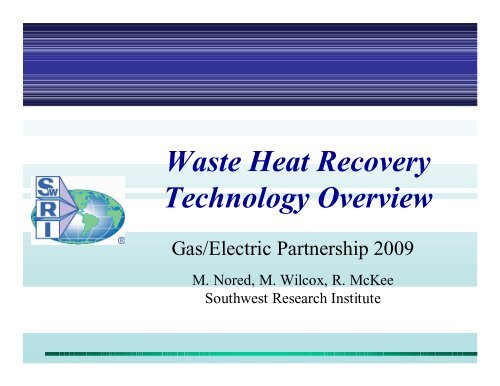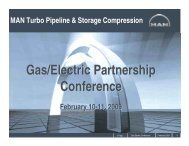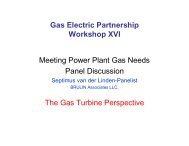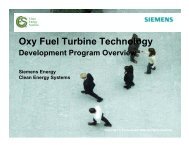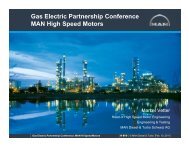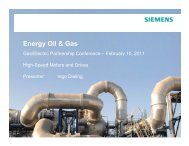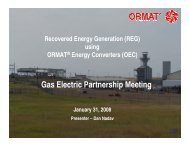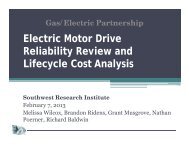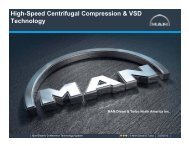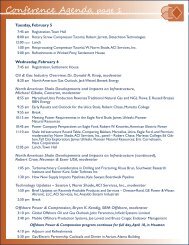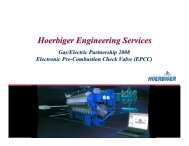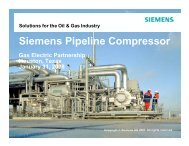Waste Heat Recovery Technology Overview - Gas/Electric Partnership
Waste Heat Recovery Technology Overview - Gas/Electric Partnership
Waste Heat Recovery Technology Overview - Gas/Electric Partnership
You also want an ePaper? Increase the reach of your titles
YUMPU automatically turns print PDFs into web optimized ePapers that Google loves.
<strong>Waste</strong> <strong>Heat</strong> <strong>Recovery</strong><br />
<strong>Technology</strong> <strong>Overview</strong><br />
<strong>Gas</strong>/<strong>Electric</strong> <strong>Partnership</strong> 2009<br />
M. Nored, M. Wilcox, R. McKee<br />
Southwest Research Institute
Agenda<br />
What is <strong>Waste</strong> <strong>Heat</strong> <strong>Recovery</strong> (WHR)?<br />
WHR Applications<br />
• Exhaust heat electric power generation (ORC, steam)<br />
• Turboexpanders<br />
• Turbine inlet cooling – refrigeration cycle<br />
• Turbochargers<br />
• Preheating fuel (GT and recips)<br />
• GT Regenerator<br />
Summary of Concepts<br />
2
What is <strong>Waste</strong> <strong>Heat</strong> <strong>Recovery</strong>?<br />
Using the remaining heat/thermal energy to create<br />
useful energy<br />
Useful Energy<br />
• <strong>Electric</strong>ity<br />
• Power/Torque<br />
• Preheat & Refrigeration<br />
• Low Grade Steam<br />
• Hot Water<br />
Common <strong>Heat</strong> Losses<br />
• <strong>Gas</strong> Turbine Exhaust * 72%<br />
• IC Engine*<br />
• Exhaust 35%<br />
• Jacket Cooling 18%<br />
• Lube Cooling 20%<br />
• IC Engine Total 73%<br />
*McKee, R., “Energy Audit Results from a Typical Natural <strong>Gas</strong><br />
Compressor Station,” Proceedings of GMC, 2001.<br />
3
Exhaust <strong>Heat</strong> <strong>Electric</strong> Power Generation<br />
Rankine Cycle (Power Plant)<br />
Steam<br />
Q<br />
Boiler/Furnace<br />
Burning Coal,<br />
Natural <strong>Gas</strong><br />
4
Exhaust <strong>Heat</strong> <strong>Electric</strong> Power Generation<br />
Rankine Cycle with <strong>Gas</strong> Turbine Exhaust as <strong>Heat</strong><br />
Source<br />
Steam<br />
Q<br />
• Steam cycles require 24<br />
hr supervision per federal<br />
regulation<br />
• Organic fluid is<br />
combustible, potential for<br />
exhaust air mixing with<br />
organic fluid is dangerous<br />
Effects based on<br />
location and<br />
season<br />
5
Exhaust <strong>Heat</strong> <strong>Electric</strong> Power Generation<br />
Organic Rankine Cycle (ORC)<br />
Q<br />
Organic Fluid<br />
(Propane)<br />
• ORC does not require<br />
24 hr supervision<br />
Condenser<br />
• More economical than<br />
steam cycle<br />
• Equipment is physically<br />
smaller for ORC vs. steam<br />
Turbine<br />
Generator<br />
Pump<br />
<strong>Heat</strong> transfer fluid<br />
to prevent mixing<br />
of organic fluid<br />
and exhaust air<br />
Low DP on Exhaust<br />
Side (minimize back<br />
pressure on turbine)<br />
<strong>Gas</strong> Turbine<br />
Evaporator<br />
<strong>Heat</strong><br />
Exchanger<br />
<strong>Heat</strong> Transfer Fluid<br />
Atmosphere<br />
Effects based on<br />
location and<br />
season<br />
6
Exhaust <strong>Heat</strong> <strong>Electric</strong> Power Generation<br />
ORC Common Applications: Geothermal, solar panels, biomass,<br />
and cement plants<br />
ORC Manufacturers: Infinity Turbine, ORMAT, TURBODEN, Turbo<br />
Thermal Corp., etc…<br />
Economical Considerations*<br />
Capital Cost<br />
$2000 to $2,500/kW<br />
Operating Cost<br />
$0.001 to $0.005/kWh<br />
Overall Cost to Operate and Own $0.035 to $0.040/kWh<br />
Current <strong>Electric</strong>ity Purchase Prices $0.035 to $0.050/kWh<br />
*INGAA, “<strong>Waste</strong> Energy <strong>Recovery</strong> Opportunities for Interstate Natural <strong>Gas</strong> Pipelines,” 2008.<br />
7
Exhaust <strong>Heat</strong> <strong>Electric</strong> Power Generation<br />
Compressor Stations Applications<br />
• Proximity to power grid<br />
INGAA White Paper Criteria for ORC<br />
• Station Capacity > 15,000 hp<br />
• 5,250 hrs / 12 months<br />
• 50 stations of 473 meet criteria 7 existing ORC applications<br />
(~5.5 MW)*<br />
6 planned ORC applications<br />
(~5.4 MW)*<br />
6.5 MW ORC Cycle Plant<br />
Gold Creek Compressor Station, Canada<br />
Courtesy of ORMAT<br />
*INGAA, “<strong>Waste</strong> Energy <strong>Recovery</strong> Opportunities for Interstate<br />
Natural <strong>Gas</strong> Pipelines,” 2008.<br />
8
Exhaust <strong>Heat</strong> <strong>Recovery</strong> – <strong>Heat</strong> Exchangers<br />
Integral component to any exhaust heat recovery<br />
system<br />
<strong>Gas</strong> Turbines and IC Engines<br />
Require Low DP, avoid back pressure on engines<br />
Current Industry <strong>Technology</strong><br />
• HRSG – Combined Cycle Plant (<strong>Waste</strong> <strong>Heat</strong> <strong>Recovery</strong> on a<br />
large scale!)<br />
• Cogeneration – Use of waste heat to generate low grade<br />
steam or hot water<br />
• Regenerator – Preheat GT inlet air to combustor<br />
9
Exhaust <strong>Heat</strong> <strong>Recovery</strong> – <strong>Heat</strong> Exchangers<br />
Applications<br />
• Exhaust <strong>Heat</strong> <strong>Electric</strong> Power Generation (Steam, ORC)<br />
• Cogeneration (production of low grade steam and hot water)<br />
• GT Regenerator (preheat GT inlet air to combustor)<br />
• Preheat GT fuel<br />
<strong>Gas</strong> Turbine Regenerator<br />
10
Turboexpanders<br />
Generate torque through expansion of high pressure gas<br />
Applications: LNG and hydrocarbon processing applications<br />
(steady flows and pressure ratio)<br />
Natural <strong>Gas</strong> Industry: Pressure regulation from transmission<br />
pipelines to distribution lines<br />
Existing Pressure Regulator<br />
Proposed Turboexpander<br />
P 1 , T 1<br />
P 2 , T 2<br />
P 1 , T 1<br />
P 2 , T 3<br />
T 3 < T 2<br />
Turboexpanders require either<br />
pre or post gas heating to avoid<br />
crossing dew point<br />
11
Turboexpanders<br />
Turboexpander capital cost<br />
• $600 to $2300/kW (average of $1450/kW)<br />
High flow variability on pipelines<br />
• Not a constant energy source<br />
Increased O&M cost at regulating station<br />
Several installations in US in past, but since have<br />
been shutdown due to economics<br />
12
Concepts for Power Augmentation<br />
Concept Embodiment Delivers<br />
<strong>Gas</strong><br />
Turbines?<br />
Recip<br />
Engines?<br />
Considerations /<br />
Requirements<br />
Turbine inlet air<br />
cooling<br />
Multiple examples: inlet<br />
fogging,Donaldson,<br />
MeeFog Industries,<br />
AxEnergy<br />
Increase turbine<br />
power<br />
√<br />
Possible N/A<br />
Material / corrosion issues,<br />
Performance dependent on<br />
ambient temp, allows more<br />
potential fuel heating<br />
Turbochargers<br />
Turbocharge IC engine<br />
applications, common in<br />
transportation industry<br />
Increase engine<br />
power<br />
N/A<br />
√<br />
Pressure limitations, integration<br />
of generator / compressor,<br />
emissions control.<br />
Preheating Fuel<br />
Recips: water jackets or<br />
GT: direct heat exchange<br />
to fuel line<br />
<strong>Gas</strong>eous fuel and<br />
improved power for<br />
engine or GT<br />
√<br />
√<br />
1-2% of total mass flow is fuel<br />
on GT, better for recip engines,<br />
does ensure no liquids in gas<br />
fuel<br />
GT Regenerator<br />
PAL-CON, El Paso<br />
experience<br />
Increase turbine<br />
power<br />
√<br />
N/A<br />
Can aid Nox emissions, service<br />
life limited, ability to add heat<br />
limited by upper limit on turbine<br />
inlet temp<br />
13
Technical Premise: Inlet Air Cooling<br />
Air Air at at Subambient<br />
temp<br />
Ambient<br />
New T1 < Tamb<br />
Lower Temph1<br />
1<br />
Fuel<br />
Mfuel = 1-2%<br />
of Mair<br />
2 3<br />
Lower h2<br />
T3 Max Temp<br />
~ 2500 °F<br />
4<br />
T4 Temp ~<br />
900 ºF<br />
M* air<br />
(h*) M air < (hM 2air -h 1 (h2-h1) )= P comp<br />
M f (q LHV ) = M air (h 3 -h 2 ) = P burn<br />
M air+fuel (h 3 -h 4 )= P turb<br />
P tot =<br />
P tot<br />
* = P<br />
P turb<br />
+ P<br />
turb +P burn<br />
– P<br />
burn -P comp<br />
*<br />
comp<br />
Power Augmentation<br />
Concepts for WHR:<br />
2 3<br />
‣ Turbine Inlet Air Cooling<br />
‣ <strong>Gas</strong> Turbine Regeneration<br />
‣ Pre-heating Fuel<br />
Pressure<br />
1<br />
1<br />
<strong>Waste</strong> <strong>Heat</strong><br />
<strong>Recovery</strong> Step<br />
4<br />
‣ Turbocharging IC engines<br />
Specific Volume, v<br />
14
Technical Premise: <strong>Gas</strong> Turbine Regen<br />
Air at<br />
Ambient<br />
Temp<br />
1<br />
Power Augmentation<br />
Concepts for WHR:<br />
‣ Turbine Inlet Air Cooling<br />
‣ <strong>Gas</strong> Turbine Regeneration<br />
‣ Pre-heating Fuel<br />
Fuel<br />
Mfuel = 1-2%<br />
of Mair<br />
Higher h3 or<br />
2 less 3fuel to<br />
reach h3<br />
Add hot air<br />
to h2<br />
‣ Turbocharging IC engines<br />
T3 Max Temp<br />
~ 2500 °F<br />
Pressure<br />
2<br />
4<br />
T4 Temp ~<br />
900 ºF<br />
2b<br />
1<br />
3<br />
<strong>Waste</strong> <strong>Heat</strong><br />
<strong>Recovery</strong> Step<br />
Specific Volume, v<br />
M air (h 2 -h 1 )= P comp<br />
M* air<br />
M(h*) fuel (LHV)= = M* fuel<br />
P(LHV)<br />
burn<br />
M air+fuel (h 3 -h 4 )= P turb<br />
P tot =<br />
P tot<br />
* = P<br />
P turb<br />
+ P*<br />
turb +P burn<br />
– P<br />
burn -P comp comp<br />
3<br />
T3 Max<br />
Temp Limit<br />
4<br />
4<br />
15
Technical Premise: Pre-heating Fuel<br />
Air at<br />
Ambient<br />
Temp<br />
1<br />
Power Augmentation<br />
Concepts for WHR:<br />
‣ Turbine Inlet Air Cooling<br />
Higher h<br />
Fuel f<br />
=<br />
More Fuel<br />
Energy<br />
‣ <strong>Gas</strong> Turbine Regeneration<br />
‣ Pre-heating Fuel<br />
Mfuel = 1-2%<br />
of Mair<br />
2 Higher 3 h3<br />
T3 Max Temp<br />
~ 2500 °F<br />
Pressure<br />
4<br />
T4 Temp ~<br />
900 ºF<br />
2 3<br />
M air (h 2 -h 1 )= P comp<br />
M air<br />
(h*) M fuel = (LHV)= M* fuel<br />
(q*)= P burn P* burn<br />
M air+fuel (h 3 -h 4 )= P turb<br />
P tot =<br />
P tot<br />
* = P<br />
P turb<br />
+ P*<br />
turb +P burn<br />
– P<br />
burn -P comp comp<br />
T3 Max<br />
Temp Limit<br />
3<br />
1 4 4<br />
<strong>Waste</strong> <strong>Heat</strong><br />
<strong>Recovery</strong> Step<br />
‣ Preheating Turbocharging Fuel IC can engines also be easily applied (more Specific effectively Volume, at vtimes) for<br />
reciprocating engines.<br />
16
Technical Premise<br />
‣ Turbocharging IC engines<br />
2 3<br />
2 3<br />
Pressure<br />
1<br />
<strong>Waste</strong> <strong>Heat</strong><br />
<strong>Recovery</strong> Step<br />
Specific Volume, v<br />
4<br />
Courtesy of ABB<br />
(www02.abb.com)<br />
17
Turbocharging with <strong>Waste</strong> <strong>Heat</strong><br />
• Ongoing program at DOE NETL / Caterpillar<br />
to investigate recovery of exhaust energy<br />
electrically using high speed generator.<br />
• ABB: Variable turbine geometry used in<br />
recovery of waste heat from 2 stroke engines.<br />
Courtesy of DOE / OSTI Information<br />
Bridge Website<br />
Courtesy of ABB website<br />
18
Summary of Concepts<br />
Concept Delivers Cap Cost Lifecycle Cost Energy Grade Effectiveness<br />
Exhaust heat for<br />
direct power gen<br />
(ORC)<br />
Relative Rankings<br />
<strong>Electric</strong> power POOR FAIR GOOD GOOD<br />
Exhaust heat for<br />
indirect power gen<br />
Hot fluid / steam /<br />
electric power<br />
POOR POOR GOOD GOOD<br />
Turboexpander for<br />
power gen<br />
<strong>Electric</strong> power GOOD FAIR EXCELLENT GOOD<br />
Turbine inlet air<br />
cooling<br />
Increase turbine<br />
power<br />
FAIR FAIR GOOD EXCELLENT<br />
Turbochargers<br />
Increase engine<br />
power<br />
FAIR GOOD GOOD EXCELLENT<br />
Preheating Fuel<br />
<strong>Gas</strong>eous fuel and<br />
improved power for<br />
engine or GT<br />
GOOD GOOD FAIR GOOD<br />
GT Regenerator<br />
Reduced emissions<br />
or Increase turbine<br />
power<br />
GOOD POOR FAIR FAIR<br />
Produce hot water or<br />
low grade steam<br />
Hot fluid / gas GOOD FAIR POOR FAIR<br />
19
Summary Points<br />
• Effectiveness and cost to operator for many of the WHR<br />
concepts are site dependent.<br />
• <strong>Technology</strong> advancements in compressed energy storage<br />
will aid many WHR options, especially turboexpander or<br />
steam drive.<br />
• Operators need to assess options, based on lifecycle<br />
costs, capital costs and power grid considerations for a<br />
given site.<br />
• Combinations of these technologies may prove to be the<br />
most useful to operators and should be considered.<br />
Examples: Turbine inlet air cooling and pre-heating fuel or<br />
Turboexpander and waste heat exchanger.<br />
20
Questions?<br />
• Marybeth Nored<br />
• mnored@swri.org<br />
• 210-522-3905<br />
• Melissa Wilcox<br />
• mwilcox@swri.org<br />
• 210-522-6046<br />
• Robert McKee<br />
• rmckee@swri.org<br />
• 210-522-5862<br />
•Justin Hollingsworth<br />
•jhollingsworth@swri.org<br />
•210-522-3000<br />
21


